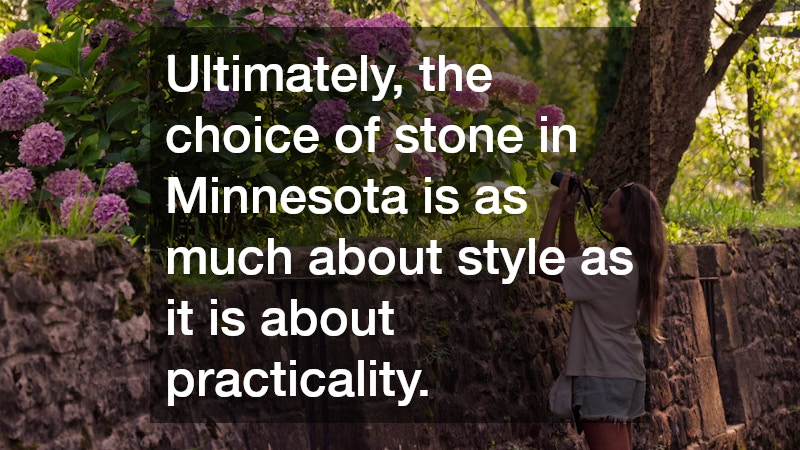

Hardscaping in Minnesota, particularly using stone, plays a significant role in enhancing the aesthetic appeal and functionality of outdoor spaces. The timeless beauty of stone can transform any garden or backyard into a breathtaking masterpiece. Beyond its visual allure, stone offers unmatched durability, a trait particularly essential for withstanding Minnesota’s varied climate. Popular types of stones used in the region include granite, limestone, and quartzite, among others.
Each of these stones brings unique qualities that make them suitable for different hardscaping purposes.
In Minnesota, where the seasons oscillate between lush summers and harsh, snowy winters, choosing the right stone is crucial. Granite is a favorite due to its resilience against freezing temperatures and its diverse color palette. Limestone, on the other hand, provides a softer appearance and is often used for elegant walkways and patios. Quartzite, celebrated for its durability and striking appearance, offers a stunning option for those seeking a more upscale look in their hardscaping projects.
Ultimately, the choice of stone in Minnesota is as much about style as it is about practicality. By understanding the intricacies of stone types and their interaction with the local climate, homeowners can craft outdoor spaces that are both beautiful and enduring. This balance of aesthetics and functionality makes stone an ideal material for hardscaping projects throughout Minnesota.
How does the Minnesota climate affect stone usage in hardscaping?
The Minnesota climate poses unique challenges for homeowners looking to incorporate stone into their hardscaping projects. The state experiences a wide range of temperatures and weather conditions, from hot, humid summers to harsh, freezing winters. These fluctuations can affect the longevity and performance of stone structures. It is essential to choose stones that can withstand extreme temperature changes and the freeze-thaw cycle, which is common in this region.
The freeze-thaw cycle can lead to significant wear and tear on stone surfaces. Water seeps into small cracks or pores in the stone and expands as it freezes, causing the stone to crack or break over time. To mitigate this issue, homeowners should opt for denser stones like granite or quartzite, which are less porous and more resistant to moisture intrusion. Ensuring proper installation with adequate drainage can also help prevent damage from water-related issues.
Beyond the physical implications, the Minnesota climate also impacts the visual aspects of stone hardscaping. Seasonal changes can cause color variations in natural stone, adding an ever-evolving aesthetic to outdoor spaces. This dynamic quality can be an advantage, allowing homeowners to enjoy different facets of their hardscaping as the seasons change. By selecting the right type of stone and maintaining it properly, it is possible to create stunning, long-lasting hardscapes that thrive even in Minnesota’s challenging climate.
What are the best stone design ideas for a Minnesota landscape?
Designing a Minnesota landscape with stone offers endless possibilities, each capable of transforming an ordinary outdoor area into an extraordinary retreat. One popular approach is to create a stone patio or seating area using large, flat stones like flagstone or bluestone. These stones provide a stable and attractive surface for social gatherings while complementing the natural surroundings. The large and flat nature of these stones ensures easy installation and a clean, modern look.
In addition to patios, stone pathways are a beautiful and functional addition to any Minnesota landscape. Using gravel or crushed stone interspersed with stepping stones can create visually appealing walkways that guide guests through the garden. These pathways can be designed with curves and varying widths to add an organic feel and maintain harmony with the existing landscape. Pebble stone is often used in these designs, offering enhanced drainage and weather resilience.
Water features, like small stone fountains or cascading waterfalls, can add tranquility and sophistication to a backyard. Stones such as river rock or cobblestone work well for sculpting these features, providing the perfect blend of form and function. Incorporating natural elements like these not only elevates the aesthetic appeal of the landscape but also contributes positively to the ecosystem by attracting birds and other wildlife. The careful selection and placement of stone elements can create a serene, cohesive environment that reflects both personal style and respect for Minnesota’s unique landscape.
Conclusion
Incorporating stone into your hardscaping in Minnesota can revitalize any outdoor space, combining beauty with practicality. From patios and pathways to water features and garden borders, the use of stone provides endless design possibilities. The key to success lies in choosing the appropriate stone types that can withstand the local climate while complementing your personal aesthetic. With careful planning and consideration, these durable materials can yield stunning, long-lasting results that continue to impress through the changing seasons.
As you embark on your hardscaping journey, remember the transformative power of natural stone. Not only does it enhance the beauty and functionality of your landscape, but it also offers a timeless appeal that endures over time. By embracing the characteristics of stones suited for Minnesota, such as granite or quartzite, you can create an outdoor sanctuary that remains vibrant and inviting all year round.



